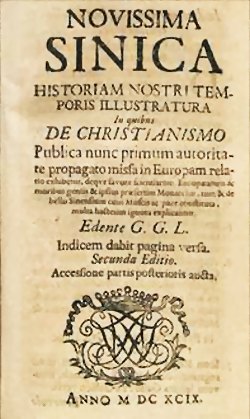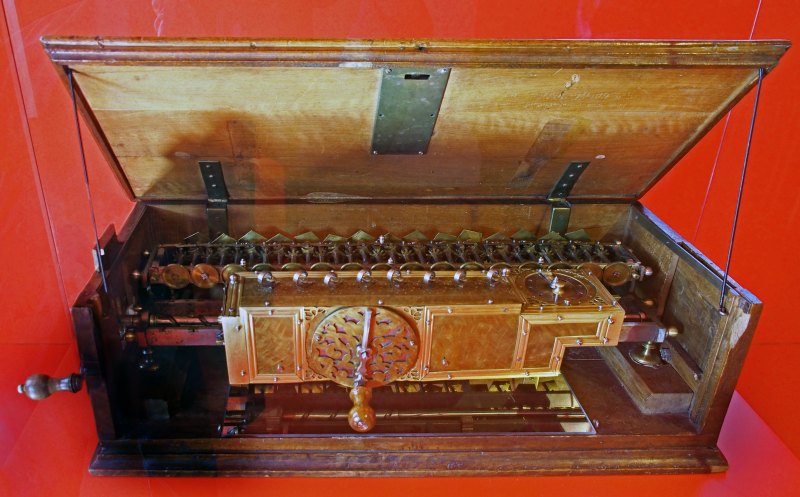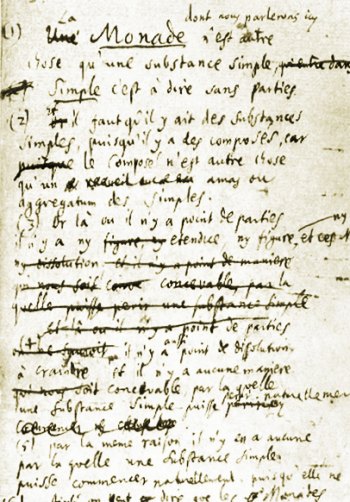Leibniz's News from China 1697

Of all the early friends of China in Europe the most prominent and influential must surely be Gottfried Leibniz (1646-1716). He was the heir to Erasmus and a great thinker in many fields of science and philosophy. Leibniz discovered binary arithmetic and so has as good a claim as any for the development of all modern computer technology. Joseph Needham ➚ terms him a ‘bridge-builder’. He was obsessed with all things Chinese and used the term China in his writings more often than any of the other term. At the time he knew more about China than anyone who had not actually visited the country. For many he is most widely known through Voltaire's Candide ➚ because Leibniz was the butt of his parody in the form of the character Pangloss. It is Pangloss that quotes Leibniz as saying we live in ‘the best of all possible worlds ➚’ that reflects Leibniz's extremely positive outlook on life. More recently Leonard Bernstein set the story of Candide as an operetta ➚.
Leibniz is little known now because he did not write many books; instead he chose to engage in writing letters to key, influential figures throughout Europe. In the English speaking world we are conditioned to honor Sir Isaac Newton (1643-1727) above Leibniz. Leibniz and Newton ➚ came into conflict over who discovered the mathematical calculus. It now seems that they probably discovered it independently but Leibniz published his ideas first. Newton was paranoid and petulant, obsessed with people stealing his discoveries while Leibniz corresponded with a great many people sharing his ideas with them. If you look at all that is known about the two rivals it is Leibniz that you would want to meet not Newton. Leibniz was the bridge to China in the sense that he pored over all the new ideas coming back from the Jesuit mission to the Imperial court. In 1689 he spent six months at the Vatican Library which housed all the knowledge garnered by the Jesuits. He corresponded with the Jesuit priests while they were at Beijing avidly consuming glimpses of an ancient and in many ways superior civilization. In his Preface to his ‘Novissima Sinica’ (News from China) published in 1697 he sees China as superior in ethics and the legal system while Europe was ahead in mathematics and warfare. He saw the opportunity of China and Europe embracing each other culturally and bringing benefit to the whole world. His stance of multiculturalism without a hint of racism was soon to lose out to a European sense of superiority.
Leibniz's Calculus
The invention of mathematical calculus opened up whole new areas. Instead of looking at the static system of Euclid ➚, engineers and scientists could look at systems in the process of change and also handle infinite series. Although it cannot be claimed that Leibniz based his theory on existing Chinese ideas it is true that work by Liu Hui ➚ of the 3rd century CE did some study of the calculation of the volumes of objects which could have provided Leibniz with much food for thought.

Rites Controversy
It’s impossible to avoid entering the puzzling world of the ‘rites’ which was the main contention between China and Europe. The question was whether the Chinese were worshiping or just venerating Confucius as well as their ancestors. If there was an element of worship (expecting something supernatural in return for the ceremony) then it was incompatible with Christianity. However there was more to it than that. The Catholic Church had the Reformation ➚ to contend with back in Europe and other Catholic orders (e.g. Franciscans and Cistercians) took a different approach to converting the Chinese. The view of the Jesuits had been to so impress the Imperial court with their skills in astronomy, mathematics and map making that the Emperor or at least leading court officials would convert to the faith. Other missionary orders worked with the poor and considered conversion would come best by winning over ordinary people. Was top-down or bottom-up the best way? It seemed that the Jesuit approach was working; there had been some notable conversion and in 1692 an edict of tolerance was made that allowed for the free movement of Jesuits.
In his writings on the ‘Cult of Confucius’ Leibniz strongly supported the Chinese side against that of some Jesuits - particularly Father Niccolò Longobardo ➚. The term ‘accommodationist’ was used to describe those who thought the Confucian Rites could be accommodated within Christianity. Leibniz sincere belief was that ancient Chinese rites were compatible with Christian theology. He supported the slow assimilation approach of Matteo Ricci. He believed there was a concept of an incorporeal ‘reason’ permeating all things. The ‘worship’ of Confucius was merely a reverence for a universal rational existence and not idolatry.
Europe was in the middle of 'The Enlightenment' where new ideas were being discussed outside the rigidity of a Catholic church orthodoxy. The newly translated works of Confucius received wide acclaim. It was thought Confucius's views on ethics were in tune with the new spirit of free thinking. It amazed people that the Chinese shared the same general views 2,000 years before this time.

Primal Language and the Clavis Sinica
Leibniz was fascinated with the Chinese written language. As early as 1679 he was interested in finding a key (Clavis Sinica ➚) to understand the characters. Like many European intellectuals it was seen as a code that needed deciphering like the Egyptian hieroglyphs. Was there a logic to the structure of each character? Leibniz was intrigued by the work of the first British sinophile John Webb who believed that the Chinese language was the primal language that is the first language spoken by Adam and all people up until the Tower of Babel ➚. Webb must have discovered that some Chinese characters clearly represent actual or abstract things. This makes it much more universal than a phonetic language such as Latin, German and French. One researcher, Andreas Müller produced great excitement in 1674 when he claimed to have discovered the key, but this seems to have been a fraud – no Clavis Sinica was ever published by him. Leibniz later came to learn that Chinese has a phonetic hint (radical) in most of the characters and so it has much less appeal as a universal written language. Leibniz proposed that a new language should be devised based on the concepts of written Chinese. He shared the view of Robert Hooke ➚, Ward and Wilkins that a new language for scientific discourse would remove ambiguity that could simply express ideas in pure logic. He wrote to Louis XIV ➚ (the Sun King ) to suggest everyone should be taught in this new universal language.
Leibniz's main source for all things Chinese was the brilliant Jesuit Joachim Bouvet ➚ (16556-1730) who arrived in China in 1687. After publishing a very favorable biography of Emperor Kangxi ➚ in France 1699 Bouvet started a very important correspondence with Leibniz. They shared views on the five ancient classics of Chinese literature.

The Yi Jing and Binary arithmetic
Although Leibniz's main legacy is the calculus, his discovery of binary arithmetic seeded the idea in European minds of the simplest number system. Counting in just binary 0s and 1s cannot be any simpler. It paved the way to all modern computer technology. Leibniz was greatly encouraged in his study of number systems by the apparent use of binary in the ancient Chinese Yi Jing.
The Yi Jing is a set of all possible 64 combinations of six broken or unbroken lines. It had been translated by Father Baptiste Regis ➚ into Latin in 1730s but Leibniz also knew it from Father Bouvet. It is a binary system of 2 to the power 6 (64) choices where the broken line is zero and the unbroken ones represent one. Although he could find no current usage of binary arithmetic in China at that time he believed that was because ancient knowledge of binary arithmetic from 3,000 years ago had been lost. However since his time no evidence has come to light that the Yi Jing demonstrates knowledge of binary arithmetic - they were always just combinations. The 64 hexagrams are arranged as an apparently random sequence of pairs. The second member of the pair is the reverse of the first except for the three cases where the hexagram is symmetric and then the inverse is used for the second pair (hexagrams 1 & 2; 28 & 29 and 30 & 31). There is no apparent logical reason why the first of the first pair decimal value 63 (binary 111111) should be followed by 34 (binary 100010) as the first in the second pair.
The fact that the Chinese apparently had knowledge of the binary system encouraged Leibniz to push forward his system. It demonstrates how an influx of ideas from one culture can catalyze developments in another. In 1697 Leibniz wrote to Father Verjus “This new philosophical counting (binary), since it is common to all languages, will give even the remotest peoples, whose speech differs so widely from our own, such as the Chinese, an idea of the most important and highest truths of natural religion.”. Leibniz in 1673 brought a mechanical calculating machine ➚ he had invented to London capable of multiplication proving that the idea of ‘computer’ was not very far away.
Diplomatic initiatives
Leibniz worked tirelessly to enhance understanding particularly European relations with China. He wanted to found Scientific Academies across the world that would bring about a universal civilization. He proposed that a team of intellectuals should go to Beijing. However the Jesuit mission zealously guarded their privileged access to the Imperial court and this initiative came to nothing.
His general view of civilization can be summed up in a quote from his book ‘News from China’ :“Now the Chinese Empire, which challenges Europe in cultivated area and certainly surpasses her in population, vies with us in many other ways in almost equal combat, so that now they win, now we.” He saw the importance of teaching the obligation of an individual to society to maintain social order. He was particularly impressed by the respect for elders and scholars which led to the smooth functioning of society in China. He believed Europe could learn much from China on the practical use of philosophy. In fact he thought that China was superior to Europe – except for the lack of Christianity.
Leibniz’s view of China was taken up by Montesquieu ➚ (1689-1755). Interest in France led to foundation of first academy of sinology at Naples to further the study of Chinese language and culture.
In 1711 Leibniz met the enterprising Tsar Peter the Great ➚ of Russia at Hanover. Thereafter he took a keen interest in Russian affairs. He proposes a scientific expedition to China 1695 via Russia to maintain good overland contacts and widen the cultural understanding of China. He wrote to the Tsar begging him to instigate this important mission, but other events intervened and it all eventually came to nothing.

Lebniz's Monads
The main philosophical legacy of Leibniz is his work on what he called monads ➚. Up until then most European thinkers reasoned that the whole world ran, apart from human beings, as a centrally controlled machine. Each part had no reason or independence – it was an unseen god that ran it all. Leibniz boldly postulated that things have an inbuilt knowledge and independence while working within a greater harmony. Monads were a little like atoms in that they are indivisible - splitting one into two would not create two functioning monads. The theory seemed a good answer as to how a seed knows how to grow into a particular species of plant or an egg into a fish. It could do this because had an inbuilt rational ‘programming’ that controlled development without the need for an external agency. This concept of ‘organism’ revolutionized biology. It can be seen as a major step that was eventually vindicated by the discovery of DNA that is indeed the inactive agent that controls how each organism develops.
The concept of monads was, Leibniz believed, present in Chinese philosophy. Birth and death are unfoldings and shrinkages that are present in Daoist thought as the flow of Qì , 气 - the life giving force that permeates all things. From Neo-Confucianism comes Lǐ 理 - the great reasoning that infuses everything.
Decline of prestige and death
At one time Leibniz was the most respected mind in Europe, he was a fellow of the British Royal Society and the Berlin Academy of Sciences ➚ which he founded. He served the House of Brunswick ➚ faithfully for many years but events turned against him. His patron, the Elector of Hanover moved to England in 1714 to become King George I. His chief friend and supporter was the Elector's wife Sophia who died in 1698. At this time in China the Emperor Kangxi became rather fed up with the bickering between factions on minor points of obscure Christian doctrine and sent them packing. China briefly showed interest in the European advances in pure sciences. For example Emperor Kangxi gave lessons in Euclid's elements to his own son but the interest soon faded. Politics in Rome moved Pope Clement XI ➚ to deem the Rites as un-Christian in 1704 and the Jesuit mission to China came to an inglorious end.
Leibniz became a little disillusioned about China, he believed that there was an urgent need to revise and clarify the Chinese classics to bring them back to the original intended meaning. He may have, like many others, begun to see slavish servitude in China where he had once seen respectful obedience. Although he had helped the Hanovers to take the British throne he received no reward and died with little pomp in 1716; indeed his grave went unmarked for more than 50 years.
Leibniz's great intellect allowed him to understand and propagate the discoveries from Chinese civilization and these new ideas served as a catalyst for change in many significant new directions in western scientific and technical development – truly he was a great bridge-builder.